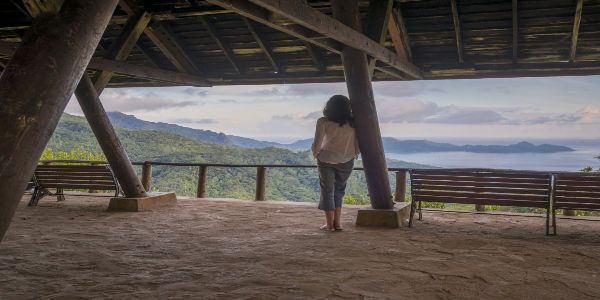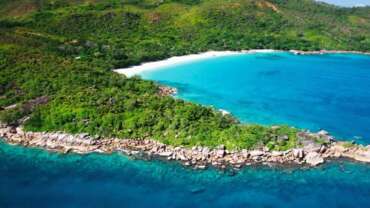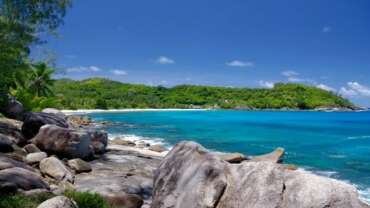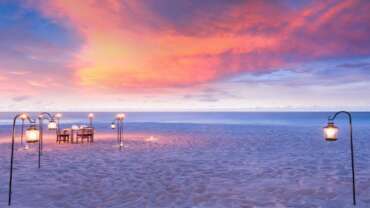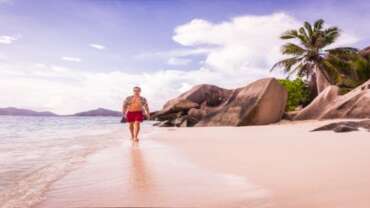Special Interest Activities in Seychelles!
This section features profiles of Seychelles’ principal niche markets: diving, fishing, romance and Sailing and provides information about these activities and where and how they can be enjoyed.
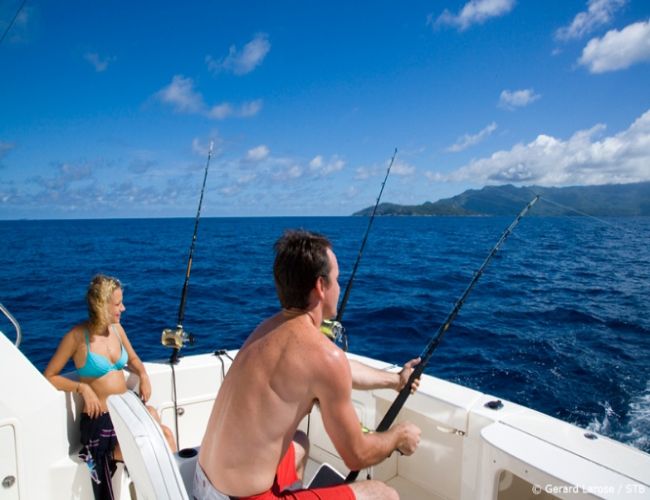
FISHING
YOU DO NOT HAVE TO VENTURE FAR FROM SEYCHELLES’ SHORES TO BREAK FISHING RECORDS IN THE ARCHIPELAGO.
International sport and recreational fishermen enthusiastically return each year to these waters that already boast world records for striped bonito, bonefish, giant guitarfish, bigeye trevally, bluefin trevally, giant trevally, moustache grouper, humpheadmaori wrasse and dogtooth tuna.
Fishing in Seychelles
Seychelles has some of the richest fishing grounds in the world. The abundance of wahoo, sailfish, dorado, tuna, rainbow runner and trophies such as marlin, make for an unforgettable big-game fishing experience for both the seasoned and novice fisherman alike.
Traditional bottom-fishing produces a dazzling array of grouper, job fish, snappers and emperors, rewarding you with some of the finest tasting fish on offer anywhere in the world.
Seychelles has become the epicenter of salt-water fly-fishing and casting your fly lines on the magnificent shallow flats of the Outer Islands will afford you the chance of landing several energetic silver bonefish to challenge the record books. Blue-water fly-fishing is also becoming increasingly popular, providing the ultimate challenge of landing large pelagic fish on relatively light tackle.
Fishing around the islands
The Inner Islands consist of 41 granitic islands that form a cluster around the principal islands of Mahé, Praslin and La Digue, some with peaks rising nearly 1,000m high. Interestingly, there are also two low-lying coral islands, namely Denis Island and Bird Island within the Inner Islands.These islands offer a variety of fishing grounds that are easily reached by Seychelles’ fleet of modern fishing craft and whose crew each have their own favorite spots where they will be happy to introduce both the fishing aficionado and novice to the thrills of deep-sea and bottom-fishing.
The Inner Islands are convenient for both full and half day fishing excursions and offer exciting fishing opportunities for spectacular – and tasty – catches. Inner Island trips can take fishermen as far north as Bird and Denis Islands, where the ocean floor plummets to 2,000 metres.Similarly, the islands of Frégate to the east, North Island and Mahé’s lofty neighbor, Silhouette, all posses fertile fishing grounds and offer the opportunity to catch a wide variety of fish.Seychelles’ dazzling chain of Outer Islands and their seldom visited fishing grounds present unique opportunities for the intrepid fisherman to do battle with the heavyweights. Seychelles holds a number of International Game Fish Association (IGFA) records for species caught in and around the outer islands.
These include the bonefish, dogtooth tuna, moustache grouper and bigeye trevally.The resorts of Desroches Island in the Amirantes group and Alphonse Island offer convenient bases for forays in areas legendary for their fishing where big-game, fly and bottom fishermen alike can test their skills to the limit.Further afield, sparsely populated islands such as Providence, Farquhar and Cosmoledo, accessible on long-range fishing expeditions, present the ultimate challenge to the fisherman in search of an exceptional fishing experience.
Fishing Types
Whether you are an experienced sports fisherman or an enthusiastic beginner, you will be thrilled by the opportunities that Seychelles’ fish-rich waters offer.Try your hand at big-game fishing and the unforgettable experience of trolling in pristine, azure waters from a range of modern fishing boats. Experienced crew will help you exceed your fishing expectations beyond your imagination.Alternatively, you can try fly-fishing in the shallow waters surrounding the Inner Islands or even practice the art of blue-water fly-fishing.
The traditional technique of bottom-fishing will land you a catch of spirited coral-reef fish and grace your table with some of the tastiest fish in the world.Meanwhile, Seychelles’ Outer Islands offer the experienced fisherman the opportunity to enter the record books in remoter waters, far from the more commonly visited fishing grounds.Big-game fishing in these virgin waters provides the ultimate challenge as does fly-fishing from the fish-rich flats of the St.
François, Poivre and d’Arros atolls.Blue-water fly-fishing in the waters surrounding these lost island worlds can yield extraordinary results as can bottom-fishing expeditions in the deeper waters where the monster coral fish dwell. Not to be missed is the excitement of night-fishing for pickhandle barracuda or shark off a variety of island locations.
The Catch
The fishing grounds around the Inner Islands offer both the big-game and fly-fisherman a varied catch that includes the spectacular marlin, sailfish, wahoo, greater barracuda, rainbow runner, milkfish, bonefish, trevally, barracuda and jobfish as well as varieties of bonito and tuna.The bottom-fisherman, meanwhile, can pit his skills against snappers, coral-trouts, seabass and groupers – just a few of the spectacular species to be found around the Inner Islands.
The Outer Islands offers a chance to test one’s game-fishing skills against the mighty marlin, sailfish, giant dogtooth tuna and yellow fin tuna, the larger ocean-going sharks and many other species.Several of the outlying atolls such as those in the Amirantes and Alphonse groups are considered to offer the best fly-fishing in the world and the chance to enter the record books with catches of 5kg bonefish, 25kg trevally and also barracuda. Given the abundance of fish, blue-water fly-fishing can be especially challenging and rewarding.Bottom-fishing in these little-fished waters can yield groupers that weigh in excess of 30kg as well as massive trevally, kingfish, greater baraccuda, snapper, emperor and bream.
Fishing Tips
It seems that the Seychelles was deliberately designed for all types of fishing are filled. With most islands lying situated outside the cyclone belt , Seychelles allow to engage in fishing throughout the year in a marine area of more than 1.4 million km2 , with water fish around 115 shimmering Islands archipelago. With such a diversity of choice for fishing , your fishing experience in Seychelles promises to be exceptionally successful.
You are free to fish at your leisure in most Seychelles waters , however some rules to preserve this unique and fragile environment must be respected , so that everyone can enjoy now and in the coming years . Within the Inner Islands , fishing is prohibited within the perimeters of Curious, Cocos Island , Bay Port Launay / Baie Ternay and the Sainte Anne Marine National Park . To ensure that these regulations are observed , these areas are patrolled by park rangers. It is the same for the Natural Reserve of Barren, no fishing is allowed within 200 meters from the beach.
Pacific regions of the Outer Islands are also regulated commercially . For example, no fishing can only be undertaken by an operator other than the one authorized to do around Alphonse below 20 nautical miles from the island. Similarly, no fishing is allowed around the island of Aldabra , one of two sites in Seychelles World Heritage of UNESCO.
Fishing Season
Seychelles , fishing is any appreciable throughout the year is divided into specific seasons, each suitable for a more specific type of fishing but remains promising for the experienced as well as for the novice fisherman.
For example, fishing, is any activity that can be practiced throughout the year, while the months from November to May are more suitable for bottom fishing and fly fishing . On the whole territory of the Seychelles , the ocean is subject to currents ranging from 0.5 to 1.5 knots depending on the winds. There are two seasons in the Seychelles in the direction of the trade winds , which blow from the northwest ( December to March ) and southeast ( May to September ) . The north-westerly winds often lead to intermittent rain squalls and stronger winds during the period from December to March. These are sometimes associated with the presence of tropical cyclones in the southwest Indian Ocean . Fortunately , all the Seychelles lies outside the cyclone belt , except the southernmost Outer Islands .
The south-easterly trades are drier and tend to blow more evenly throughout the day and into the night , reaching their peak in July / August.
In April and November periods are quiet and sometimes windless where then the winds change direction . Periods are variable and wind accompanied by calm seas and clear waters.
Tidal effects are more apparent in the Inner Islands that ocean currents and generally reach a speed of a node but up to 2 knots in channels between islands or near underwater ridges .
Tides are semi- diurnal and asymmetrical with a period of about 6 hours between high and low tide .
The tidal range around the Inner Islands can reach up to 2 meters high and 0.9 meters minimum. Tides cause currents can be strong in the channels leading to lagoons, which can drain completely at low tide . The waves are generally moderate , ranging from 1 to 2 meters and becoming higher only in case of strong winds.
Currents up along and around the bench Amirantes often cause varying conditions in a small area.
Weather forecasts are available by calling the Seychelles radio station ( the coast ) on VHF channel 16 and normally switching to channel 26 .
Boats can also be linked by radio via the radio Seychelles .
Equipment Rental & Purchase
Seychelles, no fishing license is required for recreational fishing .
You will find fishing equipment retail corresponding to the basic needs of fishermen, but on the other hand , know that the local stores are not very supplied and do not necessarily have inventory items or your favorite brands. To avoid disappointment , it is recommended that you bring your own equipment and your supply , because there is no institution specialized fishing for rental or sale of equipment. However, if you go through an operator, it will provide you with all the necessary equipment . We advise professional fishermen to check the availability of equipment with their fishing operator before booking.
Air Seychelles offers free allowance for sporting equipment not exceeding 10kg, which applies to diving equipment , golf , fishing and surfing. The equipment is weighed separately and if the weight is less than 10kg, no supplement is required. If the weight exceeds 10kg, the device is added to the weight of other baggage , and if it exceeds the free baggage allowance , excess weight will be charged at the current rate . To use this equipment allowance free sports on to Praslin , travelers must travel exclusively with Air Seychelles Praslin Island and must be reproduced on the same ticket as your international flight.
SAILING
CRUISE THE IDYLLIC INNER ISLANDS OF SEYCHELLES….. BY SCHOONER OR CATAMARAN
Since the 9th century, when intrepid Arab seafarers first sailed the then uncharted waters off the east coast of Africa, Seychelles’ waters have been visited by a succession of sailors under a host of different flags. Phoenician traders, Polynesian adventurers, a Chinese flotilla and pirates – all navigated the Seychelles archipelago, leaving little behind except footprints in silver sands and tales of buried treasure.
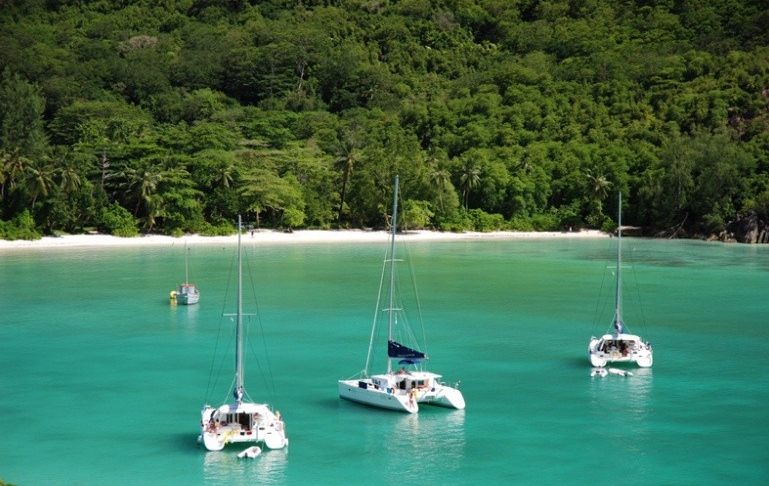
Sailing in Seychelles
Today, Seychelles welcomes a new generation of sailors to its pristine waters to enjoy the myriad treasures that have remained wonderfully intact since the occupants of Arab dhows first wondered at these islands’ astonishing beauty.
115 sparkling and diverse isles set like gemstones in an azure sea and offering year-round sailing combines with international and local charter companies that provide a wide selection of specialized craft, both skippered and bareboat, to offer the sailing experience of a lifetime.
Sailing Area
The Seychelles archipelago lies between 4° and 10° south of the Equator in the Indian Ocean and comprises 1,400,000 square km of azure ocean with 115 pristine islands that fall into 2 distinct groups, the Inner and Outer Islands and that lie for the most part, outside the cyclone belt.
The Inner Islands consist of 41 granitic islands that form a cluster around the principal islands of Mahé, Praslin and La Digue, some with peaks rising nearly 1,000m high. Interestingly, there are also 2 low-lying coral islands, namely Denis Island and Bird Island within the Inner Islands.
The remaining 72 low-lying coral islands are known as the Outer Islands and extend mainly in a gleaming arc towards the coast of Africa.
Together, these form 6 distinct island groups: the Inner Islands, the Amirantes, Southern Coral, Alphonse, Farquhar and Aldabra … all lying between 260 miles and 865 miles from the east African coast.
Sailing around Inner Islands
Enjoy the experience of a lifetime sailing the Seychelles’ Inner Islands, where safe moorings and easy sailing distances will open up a world of diversity and breathtaking natural beauty to be explored the way it was intended…under sail.
Cruise the waters around magical Mahé, Seychelles’ largest island and home to the main port and capital, Victoria. The island offers memorable sailing opportunities with 44 miles of scenic coastline that features safe anchorages, over 65 beaches and a host of secret coves and romantic hideaways.
Scenicbaysinclude Beau Vallon, Baie Ternay, Port Launay, Anse à la Mouche, Anse Soleil, Baie Lazare, Intendance and Anse Royale. Some of the more secret coves include Anse Major, Anse Jasmin, Anse Du Riz, and Petit Anse.
The smaller islands of Cerf, Moyenne, Round and Ste Anne lie just off Mahé’s eastern coast in a marine park and Conception Island and Thérèse to her west. Further in the distance northwest from Mahé lies Silhouette and its close neighbour North Island.
Only a few hours sailing northeast from Mahé (23 miles) will bring you past the twin island gems of Cousin and Cousine and to the island of Praslin, where the gentle unhurried pace of life is an attraction in itself. Praslin is home to the legendary Vallée de Mai and a choice of world famous beaches. The island boasts a wide array of hotels, shops, restaurants and other attractions, all accessible from the numerous safe anchorages that are dotted along its 18-mile coastline.
Scenic bays and romantic coves around Praslin include Anse Lazio (also one of the world’s most photographed beaches), Anse a la Farine, Anse Petite Cour, Baie Chevalier, AnsePosession, Anse La Blague, Côte d’Or and Anse Marie-Louise. Satellite islands include Curieuse, St. Pierre, ÎleCocos, Aride, Cousine and Cousin, to name a few.
Less than 4 miles southeast from Praslin’sBaie Ste Anne jetty, La Digue is the island where time stands still, with heart-stopping beauty and time-honoured tradition nestled inside 9 miles of coastline. Discover its many coves (such as Reunion, Union and Patate) and silver-sand beaches, among which is one of the planet’s most photographed strand, Anse Source d’Argent. Enjoy the charms of its numerous satellite islands like Félicité, Marianne and Grand Soeur, all within easy reach and all offering safe anchorages.
La Digue features several out-of-the-way restaurants, shops and boutiques to meet provisioning needs. And the accommodation facilities reflect island-style Creole hospitality at its best.
Then set sail towards Denis and Bird, those coralline jewels of the northern waters, or even solitary Frégate, which was once the haunt of pirates, to the east.
Sailing around Outer Islands
Journey to Seychelles’ sparkling Outer Islands, where precious few have gone before and where you can rise to the challenges of longer sailing distances and few, if any, of the numerous amenities found around the Inner Islands. Here is where true adventure lies, amid the azure world of the open ocean and the turquoise of remote lagoons.
These are areas of ocean passages, grass roots navigation and map making in the time honoured method of laying off and sounding by tender.
Some 130 miles southwest of Mahé, the Amirantes is the nearest grouping of Outer Islands to the main granite cluster of the Inner Islands. This dazzling chain of coral isles was first discovered and given their name by Admiral Vasco de Gama on his second voyage to India.
The Amirantes lends itself well to cruising, with each of its islands – from Marie-Louise and Desnoeufs to the fine resort island of Desroches, or the isle of d’Arros with its magnificent lagoon and the twin isles that make up Poivre – being only some 4 hours sailing from the next. Fishing en route is excellent and the snorkelling and diving are unrivalled, especially around the St Joseph atoll and off the walls of Desroches.
Some 50 miles southwest of Desnouefs resides Alphonse, which boasts some of the most spectacular diving, fishing and sailing opportunities in Seychelles, as well as a resort. Its lagoon is home to teeming wildlife and the majestic isles of Bijoutier and St. François. Both atolls (Alphonse atoll and St. Francois and Bijoutier atoll) are partially navigable at the right tide and both have passes to gain access to their calm interiors.
It is preferable to include Alphonse in a tour of the Amirantes and extend the visit to cover these amazing atolls. An overnight sail from the southern end of the Amirantes gives early morning access to the area around Alphonse and is a worthwhile extension for seekers of lost horizons.
The Farquhar group lies between 370 miles and 420 miles southwest of Mahé. It was the first of Seychelles’ island groups to be sighted by modern explorers and still, today, offers the sailor an authentic blue-water sailing experience.
Situated on a shallow bank of sand and coral, Farquhar is more exposed to the sea than either Aldabra or Cosmoledo and rises majestically from the ocean depths to form a low lying atoll complete with its own dazzling shallow lagoon.
Navigation within the atoll is limited and mainly restricted to the eastern section. Although entry and exit can be difficult, it is nonetheless worthwhile for the shelter offered within.
Close by is the massive Providence reef with a small island at each end. With its northern tip crowned by the protruding peak of St. Pierre, this area, detailed with fine reefs and offering excellent diving and fishing, is mostly the preserve of adventurers seeking the very last word in out-of-the-way cruising.
Flying into Farquhar for rendezvous with a pre-booked yacht is a recommended solution to avoid the long sail there and back. However, those who relish ocean passages may continue on past the Amirantes, stop over at Alphonse and finally push on to Farquhar.
Home to nesting seabirds and turtles, this remote island outpost offers the intrepid sailor a unique combination of breathtaking scenic beauty and ocean adventure.
One of the most fascinating natural places on Earth, and one of Seychelles’ two UNESCO World Heritage Sites, can only be reached by sea: Aldabra. The Aldabra group is 630 miles south-west of Mahé and consists of 3 atolls, Aldabra itself, Cosmoledo and Astove plus the raised limestone platform island of Assumption. Only Assumption and Aldabra carry skeleton staff whilst both Cosmoledo and Astove are at present uninhabited.
The relative closeness of Assumption, Cosmoledo and Astove makes for an interesting sailing itinerary around these ‘lands that time forgot.’
This area is very seasonal with the best times to visit being the transition periods of March/April and again October/November. Often the best way to visit this area is to charter a plane and fly to the airstrip at Assumption and meet up with a charter yacht.
Sailing Tips
It is as if Seychelles was deliberately designed for the recreational sailor. With most islands lying outside the cyclone belt, Seychelles offers year round sailing in calm waters. There is no better way to enjoy a dazzling array of islands than by cruising its pristine waters and exploring the extraordinary bounty of Seychelles at your own pace. Here are a few tips to help you make the most of your sailing holiday experience.
Current legislation mandates that all yachts visiting the Outer Islands shall be of the higher specification ‘Over 60 miles’ class and that they be supplied with captain and appropriate crew. The charter companies can advise which of their yachts are equipped to visit these areas.
Fringing reefs and shallows make navigation a full-time occupation and currently only crewed charters are offered in the Outer Islands. Anchorages tend to be better during the south-east trades (May to September) or during the calmer transition months (April and October), although each island may have its own particular configuration for favourable moorings depending on the season. Be sure to get the necessary permissions prior to landing on the various islands.
Access and Fees
While you are free to explore most of Seychelles’ waters at will, there are a few limitations which are often meant to help preserve the unique and fragile environment so that all can enjoy it today and in the years to come.
Access to the ecologically sensitive Marine Parks and Reserve areas are managed by various conservation organizations and requires either permission, and/or payment of a landing or entry fee, and mooring fee for overnight mooring. However, streamlined procedures now make it easy for yachts to visit. Simply arrive and anchor in the marked zones and the marine park officials will come out and visit the yacht to collect the required fees.
The Marine Parks and Reserves areas are: Aride, Cousin, Curieuse Marine National Park, ïleCocos Marine National Park, Ste. Anne Marine National Park and St. Pierre. Entrance fees start from Euro 10 per person. Overnight mooring fees start from Euro 10 per yacht.
Some islands are privately owned or managed, therefore access is controlled by the owners. Islands that fall into this category are: Anonyme, Bird, Chauvre Souris, Cousine, D’Arros and St.Joseph Atoll, Denis, Félicité, Frégate, Grande Soeur, Petite Soeur, Moyenne, North, Round Island off Mahé and Round Island off Praslin. Please contact the island management for permissions. Landing fees start from Euro 10 per person.
The following islands are under the management of the Island Development Company (IDC): Alphonse Island, Bijoutier, Coëtivy, Desroches, Farquhar, Poivre Atoll, Platte, Providence Atoll, Remire, Silhouette and St. François. Please contact IDC for permission to access. Landing fees start from Euro 20 per person.
Entry and Exit Formalities
Port Victoria on Mahé is the only official port of entry and exit of the Seychelles. Locally chartered yachts that will sail within Seychelles are not subject to entry and exit formalities.
However, all vessels arriving from a foreign country or departing Seychelles must call at Port Victoria to carry out all customs, health, immigration, port and security formalities.
Vessels must submit the following documentation to the customs authorities upon entry:
1) A valid outward clearance from their last port of call
2) Crew list
3) Passenger list
4) Store (or consumables) list
5) Arms and ammunition list
A one-month visitor’s permit is normally issued to crew members and accompanying passengers (if there are any) on arrival. Extension of the permits must be sought at least one week prior to its expiry should they decide to stay longer. If a trip to the Outer Islands of Seychelles is planned and the return to Port Victoria, Mahé will be later than the expiry date of their permit, visitors must secure the extension of their permit prior to embarking on their journey.
Immigration must be advised in advance and in writing of any crew member or accompanying passenger either signing off or joining the vessel.
Upon exiting Seychelles, vessels must complete the outward clearance formality with the customs authorities and are not allowed to call at any of the islands once cleared by the relevant authorities in Port Victoria.
The islands of Assumption, Farquhar and/or Desroches may be substituted as alternative entry or exit ports, but this is a very costly option, as all officials concerned will have to be flown out from Mahé at the requesting vessel’s own expense.
Moorings/Navigation
Sailing within the Inner Islands is easy and safe, with sailing distances of under 32 miles between mooring grounds.
Mooring buoys are provided in several locations (particularly around north-west Mahé, north-east of Praslin and a few of its surrounding islands) and should be used where available; otherwise anchoring is required. Good sand bottom anchorages with depths of 5-8 metres may be found in most of the desired overnight areas. In line with Seychelles’ eco-friendly policies, ANCHORING ON CORAL IS STRICTLY FORBIDDEN.
In the Outer Islands that lie between 130 miles and 630 miles from Mahé, navigating is more difficult due to the presence of low-lying coral reefs and other hazards. The mooring grounds of many Outer Islands are less sheltered and the waters between them less frequently sailed.
1/10000 scale charts of the ocean surrounding the islands have been published as mooring guides and are available in the offices of Sunsail and VPM (two sailing operators based in Seychelles) and on the yachts themselves. Due to the remoteness of the islands and the infrequency of mapping surveys the correct depths (surroundings) are sometimes missing or inaccurate, so care should be taken to sail cautiously over the mooring zones and in waters surrounding the more remote islands. Do not trust the printed figures blindly as coral bottoms can vary constantly, obliging the skipper to be alert to the sounder at all times.
Navigation aids are provided at Port Victoria and at the entrance to the Port, as is the case at the BaieSte. Anne jetty on Praslin. The buoyage system is based on the IA system, as in Europe. Red cylindrical buoys and even numbers to port; green cones with odd numbers to starboard. There are also a few lights with charted characteristics positioned on headlands of Mahé and Praslin.
Apart from these, navigation is by pilotage. The return to compass, chart and feel is a most refreshing change from the world’s buoyed and beaconed waters.
Sailing by chart is both enjoyable and rewarding and with due care for the well charted rocks and reefs makes Seychelles a delight to navigate. The most severe offshore rocks are visible by eye but do not carry buoys or lights.
Self-skippered yachts are therefore limited to daylight hours only and are required to be at anchor by nightfall.
Special Zones have been designated around areas or foul ground, underwater pipelines and cables and areas of special interest or security where care with anchoring and access to the beach are required.
For example, in Beau Vallon Bay on Mahé, there are zoned anchorages and access channels around designated swimming areas.
The art of sailing is a combination of reading the weather, using it to one’s advantage, avoiding dangers and using depth, bearings and transits to navigate freely, enjoy the voyage, and finally anchor in a safe and beautiful location. Seychelles provides this in abundance.
Sea Conditions
Throughout Seychelles the ocean is subject to currents with speeds of 0.5 up to 1.5 knots that develop with the trade winds.
The currents over the Seychelles Bank are on average 0.4 to 0.8 knots and increases around local obstructions and headlands.
The effects of the tides are more noticeable within the Inner Islands than the ocean currents and are generally less than a knot, increasing to up to 2 knots in channels between islands or close to underwater ridges.
Tides are semi-diurnal and asymmetrical with about 6 hours between high tide and low tide. The tidal range around the Inner Islands can get as high as 2 metres at spring tides and as low as 0.9 metres at neaps. Tides give rise to currents that can be strong in the channels leading to lagoons, which may empty completely at low tide.
The tidal range at Aldabra is 4 metres at springs and 1.8 metres at neaps.
Swells are generally moderate with waves of up to 1 to 2 metres becoming higher only in strong winds on open water.
Currents and upwellings around the Amirantes Bank often cause choppy conditions in a small area whilst currents in the Aldabra region run up to 2.5 knots and tidal streams around the atolls reach 3 knots at spring tides.
Water and Refuelling Facilities
Water and refuelling facilities are available on the islands of Mahé, Praslin and La Digue at the areas listed below.
On Mahé, local charter yachts may use the facilities available at the Marine Charter Association, Port Victoria. However, foreign yachts must contact the Harbour Master at Port Victoria at least 24-hrs in advance.
Winds
There are two opposing wind patterns in Seychelles, blowing seasonally either north-westerly (December to March) or south-easterly (May to September).
In general, the north-westerly winds strengthen at daybreak, however, it is relatively weak with average wind speeds of 5-10 knots and reaches its peak strength in January. The north-westerly trades often have intermittent rain squalls and stronger winds during the period December to March. These are sometimes associated with the presence of tropical cyclones over the south-west Indian Ocean. Remember that all but Seychelles’ most southerly islands lie well outside the cyclone belt.
In comparison, the south-easterly trades are drier and tend to blow more consistently throughout the day and into the night, reaching its peak in July/August. Average wind speeds during the period June to September are 10-15 knots, with occasional gusts exceeding 30 knots, normally associated with surges in the trade winds.Sailing in Seychelles – Copyright Koos Van der Lende.
In the months of April and November there are calm and sometimes windless periods when the trade winds change direction. These light and variable wind periods are accompanied by calm seas and clear waters.
In terms of strength, the Outer Islands would probably experience stronger winds during the south-easterly trades season due to their more southern location as well as exposure (low lying atolls). Whereas, the Inner Islands would expect to have stronger winds during the north-westerly trades season since the zone of weaker winds (Inter Tropical Convergence Zone) would normally be lying to the south of it.
Weather forecasts are available by calling Seychelles Radio (Coast Station) on VHF channel 16 and normally switching up to channel 26. Yachts may also place a radio link call via Seychelles Radio.
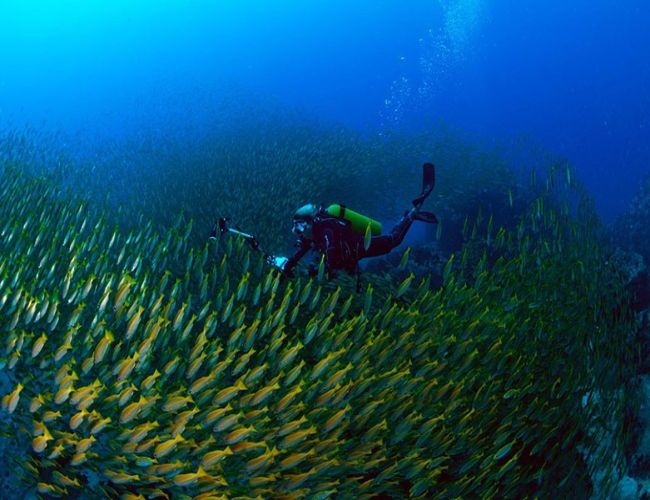
DIVING
SEYCHELLES OFFERS DIVERSE AND IMPRESSIVE DIVING OPPORTUNITIES
With 115 islands scattered across the Indian Ocean between 4° and 10° south of the Equator, Seychelles offers diverse and impressive diving opportunities.
The Inner Islands, remains of a submerged mountain range, rest on a shallow plateau with prolific marine life and excellent PADI diving facilities available to access a multitude of dive sites.
The Outer Islands to the south of the archipelago are all coralline or sand cays and mainly uninhabited, presenting the experienced diver with excellent opportunities to explore where few have gone before.
Diving in Seychelles
Seasons & Conditions
Diving is possible all year round but is governed by an island’s position and the prevailing winds. Generally speaking, the best conditions for both the Inner and Outer Islands are in the calm periods, April-May and October-November, when the water temperature can rise to 29ºC and offers excellent (up to 30 metres) visibility.
In December and January, the north-west winds blow but conditions remain much the same as in the calm periods, with the exception of greater surface movement and some localised turbidity.
From May to September the winds are stronger and blow south-easterly. Visibility and temperature may thus drop during August with water temperatures of around 25°C. A wet suit of at least 4mm is necessary.
Unlike the Inner Islands, some of the more southerly Outer Islands are close to the cyclone belt, and during these months they can experience extremely rough conditions on occasion.
A 4mm shorty wetsuit is the minimum protection recommended for the Outer Islands. Islands with big drop-offs and walls often have marked thermo-clines with temperatures ranging from 19 to 27ºC and a full suit is an advantage for most divers.
Dive Types & Depths
With 43 Inner Islands to choose from, variety is the order of the day. All of these northerly islands offer impressive granite reef locations where the sculptured rocks can be covered with soft corals and sponges, and fish life is prolific, due to the archipelago’s isolation and also strict conservation rules.
Wreck dives are available in some areas but only the islands to the south have wall dives, drop-off dives and drift diving opportunities as well.
Outer Island diving is rich and varied, featuring everything from mini-walls and canyons to migrating Manta Rays, numerous wreck sites and some of the finest Gorgonian fans in the Indian Ocean.
Diving on Aldabra’s terraced walls is dramatic and Green Turtles are common both in water and on their habitual pilgrimages up the beach to nest.
The Cosmoledo atoll offers huge hard coral bommies with 3 metre Gorgonian fans and massive barrel sponges all under the watchful guard of inquisitive Potato Bass.
Astove’s settlement reef presents another awe-inspiring wall dive whose reef top is incised with crevasses and caves and boasts a large resident Green Turtle population.
Dive depths vary, ranging from 8 to 20 metres for inshore sites and up to depths of 40 metres for dives offshore.
Marine Life
The Inner Islands’ marine life reveals an abundance of fish even on shallow inshore reefs and features different types of Butterfly fish and Angel fish, Soldier fish, Squirrel fish and Sweepers among many others. The island reefs are also havens for many invertebrates including Octopus, Spiny Lobster and a plethora of Nudibranchs, such as the Spanish Dancer.
Sites with regular current flows support fan corals and colorful tree coral formations while more remote sites shelter the larger fish species, such as the Napoleon Wrasse, Giant Grouper, Reef Sharks and Ribbon-tailed Stingrays. Most spectacular are the plankton-eating Whale Sharks found all year around the Inner Islands, with peak sightings in August, and October through January.
Marine life around the relatively isolated Outer Islands tends to be even more prolific, with frequent sightings of many of the larger grouper species, particularly the spotted Potato Bass as well as Grey Reef, Silver Tip, Nurse Sharks and the occasional Hammerhead Shark.
A number of rare exotics have been identified from this area such as the African Pygmy Angelfish thought to exist only in small numbers at depth off Mauritius and now found regularly in easy diving depths off Astove.
The cartoon-like Yellow Rubber Lipped Sweetlips is another firm favorite while elusive Long-Nosed Hawkfishcan be easily found in most Gorgonian fan areas.
Diving Tips
Seychelles offers year round diving experiences in waters mainly outside the cyclone belt and dive centers around the country cater for novice and experienced divers alike, offering a number of specialised courses.
Divers should bring proof of certification and medical clearance for any medical problem.
Most dive centres offer modern dive equipment rental and service facilities. However, repair facilities for divers’ own gear may be limited, subject to availability of specific spare parts.
Air Seychelles offers a free sporting equipment allowance of 10kg, which applies to the equipment of diving, golf, fishing and surfboards. The equipment is weighed separately and if the weight is less than 10kg no supplement will be payable. If the weight exceeds 10kg, the equipment is added with the other checked luggage and any excess weight above the specified baggage allowance will be payable. To profit from the sporting equipment allowance on connecting flights to Praslin, visitors must travel exclusively with Air Seychelles and the Praslin sector must be reproduced on the same ticket as your international sector.
It is recommended there be a 24-hour safety window between the divers’ last dives and their next flight.
Certification & Medical
Divers need to bring proof of certification to be allowed to dive. However, those who have lost or forgotten their certification cards or log-books may be allowed to dive with a Dive master to a maximum depth of 12 metres, at the discretion of the dive centre.
Those planning to take a diving course who have had a previous medical problem, should obtain and bring with them a certificate from their doctor indicating that they are fit to dive. Local physicians in Seychelles are able to perform a diving medical if required.
Education & Courses
Any medically fit person over the age of 10 and able to swim can learn to dive. Diver training is conducted by internationally qualified and insured instructors most of whom are members of PADI, the Professional Association of Diving Instructors, the world’s largest diver training organisation.
A non-certification “Discover Scuba Diving” introductory course for first timers is available leading either to the basic “Scuba Diver” qualification or a full certification as “Open Water” Diver.
Experienced diver courses are available to instructor level with specialty certifications available from certain centres, such as underwater photography, wreck and night diving.
Equipment Rental & Purchase
For visitors not wishing to bring their own, all licensed dive centres rent out properly maintained, modern diving equipment which is inspected on a regular basis.
The centres also have a range of other beach accessories available, including snorkelling equipment.
Flying after diving
To minimise the possibility of a decompression incident at the end of a diving vacation, the current recommendation is that divers should leave a minimum of 12 hours after their last dive before flying and, where possible, a 24-hour period is recommended.
The centres will not allow divers to dive on the morning of departure or prior to an inter-island or helicopter flight!
SEYCHELLES OCEAN FESTIVAL
In early December 2016, Seychelles is planning to launch the Seychelles Ocean Festival, an event that replaces SUBIOS (sub Indian Ocean Seychelles) in the calendar of events as the country’s celebration of its extraordinary marine heritage.
The Seychelles Ocean festival is a week-long happening that looks to involve all the elements which make Seychelles an amazing destination for the ultimate marine experience.
Whereas SUBIOS, which started in 1990, largely focused on raising the profile of the archipelago as a diving destination through its famous underwater video and film competitions, film shows and talks by famous, internationally renowned personalities, the Seychelles Ocean Festival looks to broaden the event’s appeal by involving all marine sectors.
This newest addition to Seychelles’ calendar of events will continue to popularize Seychelles as a diving destination via the popular photography competition and by working with the dive centres, airlines and accommodation establishments to offer appealing dive packages to tourists during the period of the festival.
Work on the new programme is ongoing but the final programme is anticipated to involve a special Gala Dinner and film show, showcasing various aspects of the Blue Economy, highlighting the attributes of Seychelles’ sailing and fishing sectors through a coordinated programme of related activities and bringing hotels on board to promote special sea-food evenings, film shows and other forms of entertainment around a marine theme.
Schools and NGOs will be encouraged to participate, especially at a family day at Anse Royale when a host of activities is planned including exhibitions, live music shows, sporting events (Iron Man & Woman), volleyball/football competitions and other cultural happenings.
The intention is for the Seychelles Ocean Festival to broaden the appeal of SUBIOS by reflecting the wider choice of marine activities which, together, make Seychelles an exciting destination to visit.
ROMANCE
WEDDING AND HONEYMOONS
Sensual Seychelles, home to the unique Vallée de Mai, claimed by some to be the original site of the Garden of Eden, has long been dubbed the ‘islands of love’ – a place where romance is as natural as the waves caressing the shores of a secret cove at midnight.
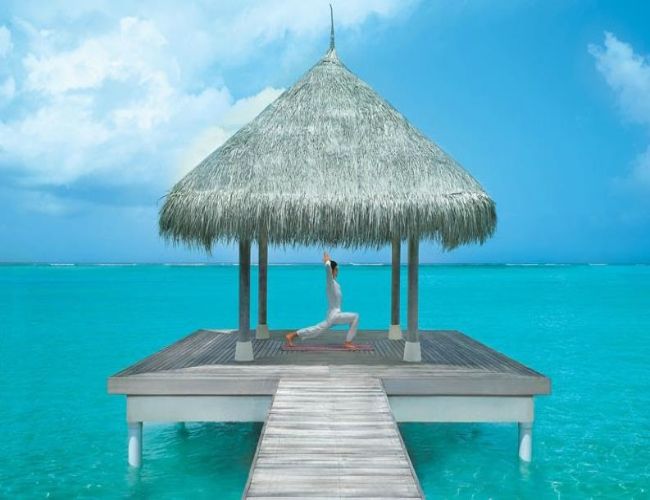
Romance in Seychelles
Seychelles is a place of safety and serenity, where an astonishingly surreal beauty and a languid pace of life conspire with an enviable tropical climate and welcoming people to provide a unique backdrop for those tender romantic experiences.
Enjoy all the diversity in accommodation that Seychelles has to offer, from charming Creole guesthouses, intimate hotels both large and small, to the magical experience of sumptuous five star resorts and exquisite island hideaways.
Celebrate your special moment with us. Be it a wedding, honeymoon or an anniversary, unforgettable Seychelles holds the key to your dreams of romance in paradise.
Weddings
Make a rendezvous with destiny and exchange your wedding vows amid the breathtaking and naturally seductive ambience of the islands of love.
Whether in the beautiful grounds of your hotel, beneath swaying palms by the beach, on a yacht heading into a magical sunset, or on one of our several enchanting island getaways, you will be spoilt for choice when it comes to venues of heart-stopping beauty.
Share your celebration with your family and friends by having them present to witness your union. Or, if you prefer total intimacy, then say ‘I do’ in splendid solitude just the two of you. Either way you will be swept off your feet by the attentions of the dedicated team of professionals, there to ensure that your wedding is organised to the very last detail of your dreams, leaving you free to savour the moment and cherish the memories for a lifetime.
Make the ultimate choice in romance, assured in the knowledge that there is no better place on earth to celebrate your commitment to each other.
Legal requirements
When planning your wedding in Seychelles, there are certain legal requirements which need to be adhered to.
Please view the Legal Requirements for Marrying in Seychelles document for more information.
Religious Ceremonies
Your dream of a romantic religious wedding in paradise can become reality in Seychelles.
Roman Catholicism is the dominant religion in the country, however there are also Anglican and other Protestant churches, as well as smaller Muslim, Hindu and Bahá’i communities.
In order to organise a religious wedding ceremony you will have to contact the relevant religious body. It is important to note however, that a religious wedding without first conducting a civil ceremony is not recognised under Seychelles law. It will therefore be necessary to conduct a civil ceremony prior to the religious ceremony.
Any one of Seychelles’ international tour operators or local ground handling operators will be more than happy to assist you with the organisation of your special day.



